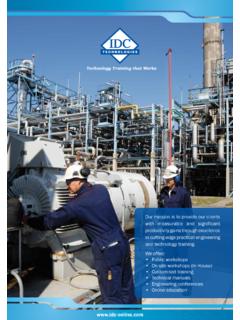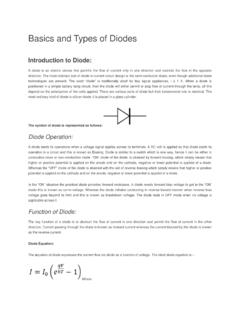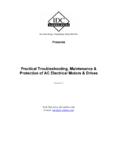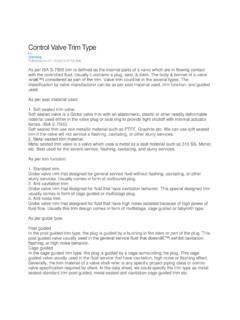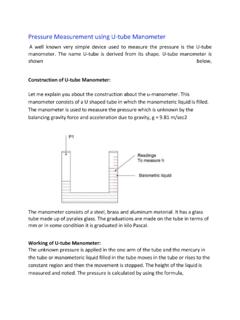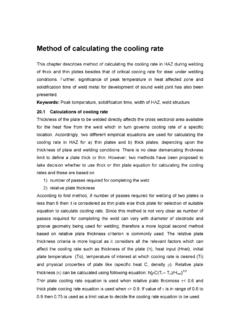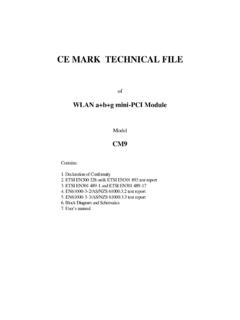Transcription of Harmonic Standard ER G5/4 Engineering Technical Report 122
1 11 The Hong Kong Institutionof EngineersBuilding Services DivisionASHRAEHong Kong ChapterTechnical Workshop on Technical Workshop on Latest Development of IEE Wiring RegulationsLatest Development of IEE Wiring RegulationsBS7671 and Harmonic Standard ER G5/4BS7671 and Harmonic Standard ER G5/4(Session 1)(Session 1)Web Sites:-CIBSE Hong Kong : HKC : BSD : HK : : IEE(HK Specialised Power Division), CIBSE ESG, IEE BETNET Supported by: The Dept of Electrical Engineering , HK PolyUThe Hong Kong Institutionof EngineersBuilding Services DivisionASHRAEHong Kong ChapterHarmonic Standard ER G5/4 Engineering Technical Report 122nGeoffrey HensmannAsset Management, Yorkshire Electricity Distribution, UKnJoint Harmonics Working GroupnGrid Code Review Panel Distribution Code Review PanelDisclaimerThis document is based on the best knowledge available to the authors at the time of publication.
2 However no responsibility ofany kind for any injury, death, loss, damage or delay however caused resulting from the use of these recommendations can be accepted by the authors or the professional Engineering institutions/committees they are a member of or their adopting these recommendations for use each adopter by doing so agrees to accept full responsibility for any personal injury, death, loss, damage or delay arising out of or in connection with their use by or on behalf of such adopter irrespective of the cause or reason therefore and agrees to defend, indemnify and hold harmless the authors involved in the publication from any and all liability arising out of or in connection with such use as aforesaid and irrespective of any negligence on the part of those of presentation What are harmonics and why do they need controlling?
3 The electromagnetic compatibility concept The IEC 61000 series of standards The development of ER G5/4 Features of G5/4and the 3-stage process Examples of the application of ER G5/4 Engineering Technical Report 122 Comparisons with other standards Summary1234567890-What are harmonics and why do they need controlling? They arises because non-linear loads are connected Typical non-linear loads are rectifiers, power supplies for electronic equipment, and variable speed motor drives. Because of the impedance of the network, the total Harmonic current from a number of such loads results in the voltage waveform being distorted as well Harmonics are a mathematical representation for the non-sinusoidal current or voltage on a power network1234567890-How harmonics make up a distorted waveformFundamental and summated harmonics give a waveform with many zero crossingsSum of fundamental.
4 3rd and effects of harmonics The harmonics add to the rms and peak value of the waveform This could mean that equipment could receive a damagingly high peak voltage and could therefore be susceptible to failure The waveform and the effects are very dependant on the phase angle. The rms value can be the same but depending on the Harmonic phase angles, the peak value can be different1234567890-To show the effects, the 3rd Harmonic phase angle has been altered by 180 Sum of fundamental, 3rd and 5th3rd and 5th harmonics at 180 of fundamental, 3rd and 5th5th Harmonic at 180 current waveforms from various loads Various types of Harmonic loads have characteristic Harmonic contents.
5 6 pulse power mode power rectifier power supply has this current waveshape when a sinusoidal voltage is applied1234567890-Source of HarmonicsNormal loadsHarmonic currents flowing through the system impedance results in Harmonic VoltageDistortionat the point of common couplingNon-linear load does not draw a sinusoidal current from a perfectly sinusoidal voltage source, solid state drives, switched-mode power supplies, fluorescent lampsSource voltageCables, overhead lines and transformers of the distribution system make up the system impedanceHarmonic VoltageDistortionimposed on another customerPoint of common couplingCustomer with non-linear load1234567890-Why do harmonics need controlling?
6 Controls are required to ensure that all connected equipment operates correctly Since 1970 there has been an exponential increase in the use of electronic equipment in commercial and residential environments In particular switched mode power supplies have become extremely common in computers, and home entertainment equipment A paper published in Japan shows that there is an increase in equipment failures at a Total Harmonic Distortion (THD) level of 8% and above1234567890-Adverse effects There are adverse effects from heating, noise, and reduced life on: capacitors and surge suppressors rotating machines cables and transformers MCBs and fuses customers equipment ranging from telephones to clocks, to interference with radio and television Distribution companies are particularly concerned that distribution transformers may need to be de-rated to avoid premature failure1234567890-How have they been controlled in the past?
7 The damage from excessive levels of harmonics was foreseen and controls introduced -Problems were from 2nd Harmonic as a result of half-wave rectifiers in television sets British Standard BS5406 (based on IEC 555 part 3) was used to control Harmonic emissions from small domestic equipment The most well known document is probably ER G5/3, which has also been the basis of standards in some other (mostly Commonwealth) countries US Standard IEEE 519 has been the basis of standards in some other counties1234567890-Why revise G5/3? The introduction of the concept of electromagnetic compatibility and the EU compatibility Directive Developments in the IEC 61000 series of Standards for electromagnetic compatibility (EMC)
8 Levels in UK at 132kV and above are higher than the Grid Code allows at a number of locations G5/3 didn t include notching and burst harmonics There is now better information on network Harmonic impedance To ensure that Harmonic emission standards apply to all industrial or commercial equipment 1234567890-The electromagnetic compatibility concept Satisfactory operation of electricity supply systems and users equipment is only obtained where electromagnetic compatibility between them exists Emission limits thereby help fulfil this objective But, just as important is the immunity of equipment to harmonics present on the supply There is a level between the emission levels and the immunity levels where there is a low probability that equipment will mal-function1234567890- compatibility in diagrammatic formDisturbance LevelProbability DensityCompatibility LevelImmunity of local equipmentPlanning levelAssessed levelSee appendix A of IEC 61000-2-12 for detailed explanation of compatibility1234567890- electromagnetic compatibility (EMC)
9 IEC 61000 series of standards IEC 61000 Contains 6 parts each with standards and Technical reports Part 1 -General -2 documents cover application and interpretation aspects of EMC Part 2 -Environment -10 documents covering classification of the electromagnetic environment and compatibility levels for different environments Part 3 -Limits -8 documents covering emission limits for harmonics and other disturbances1234567890- Part 4 -Testing and measurement techniques -21 documents describing Standard methods for testing equipment for emission of and immunity to the different disturbances Part 5 -Installation and mitigation guidelines -6 documents covering this field Part 6 -Generic standards -4 documents covering immunity and emission standards for residential, commercial.
10 Industrial and power station environments1234567890- Harmonic aspects in the IEC 61000-2 Environment series of standards IEC 61000-2-2 - Harmonic compatibility levels for public lv systems are included IEC 61000-2-4 - Harmonic compatibility levels in industrial plant are included IEC 61000-2-12 - Harmonic compatibility levels for public mv systems are included (in preparation)1234567890- Harmonic aspects in the IEC 61000-3 Limits series of standards IEC 61000-3-2 - Harmonic current emission limits for equipment connected at lv and < 16 A per phase (Currently 3rd edition is being prepared) IEC 61000-3-4 - Harmonic current emission limits for equipment connected at lv > 16 A per phase (to be replaced soon by IEC)
